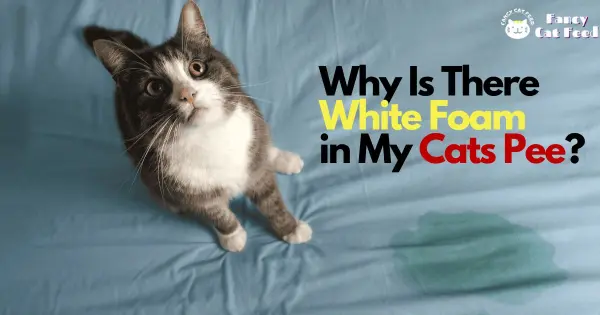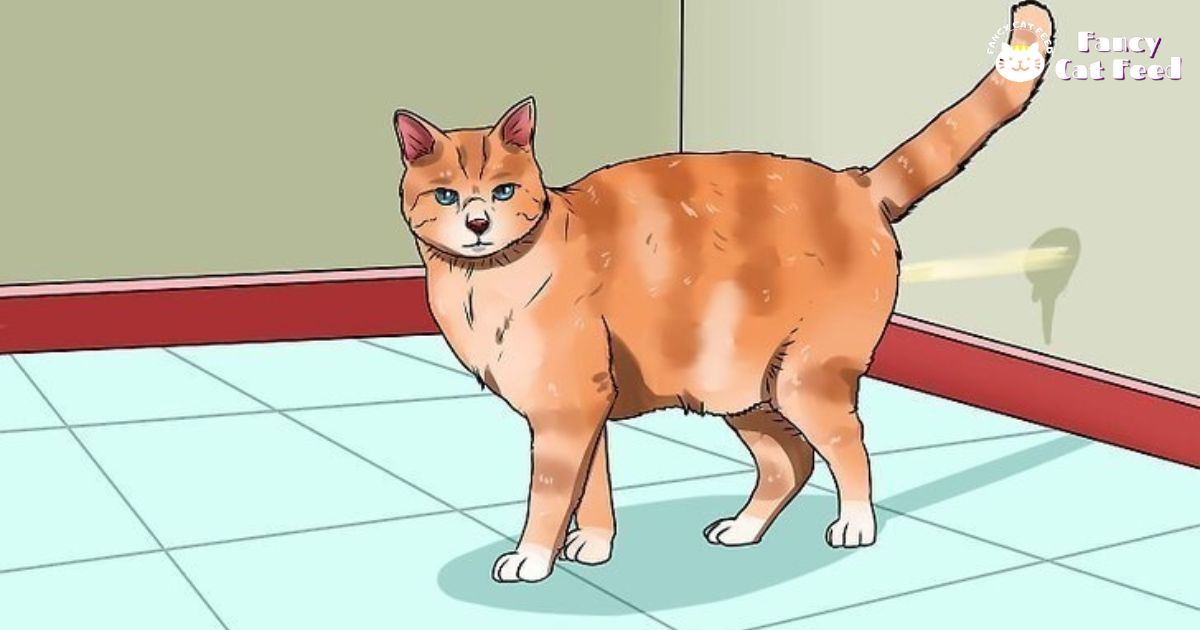Foamy cat pee may indicate issues like dehydration, dietary factors, or urinary tract infections. Dehydration can make urine concentrated, leading to foam. If you notice persistent foaming or other concerns, consult your vet for proper diagnosis and care.
Cats are known for their mysterious and sometimes perplexing behaviors, and one such concern that can raise alarm among cat owners is the discovery of foamy urine. While it’s normal for cat urine to vary in consistency and color.
The presence of foam might leave you wondering about the potential underlying causes. In this article, we will explore the reasons behind foamy cat urine and what it might indicate about your feline friend’s health.
What causes foamy urine in cats?
Foamy urine in cats can be caused by various factors, and it’s essential to consult with a veterinarian for an accurate diagnosis. Some common reasons for foamy urine in cats include:
- Dehydration: Insufficient water intake can lead to concentrated urine, resulting in foam. Make sure your cat has access to clean and fresh water at all times.
- Proteinuria: Excessive protein in the urine may create bubbles or foam. This can be associated with kidney disease or other issues affecting the urinary system.
- Urinary tract infection (UTI): Infections can cause irritation and inflammation in the urinary tract, leading to foamy urine. UTIs require prompt veterinary attention.
- Dietary factors: Certain diets, especially those high in protein, may contribute to foamy urine. Adjusting the cat’s diet under veterinary guidance may be necessary.
- Stress or anxiety: Cats can react to stress or anxiety with changes in behavior, including changes in urination patterns. This could result in foamy urine.
- Medication side effects: Some medications may have side effects affecting the urinary system. If your cat is on medication, discuss any observed changes with your veterinarian.
Why Is There White Foam in My Cats Pee?

White foam in your cat’s pee could be a sign of various underlying health issues. One common cause is the presence of crystals or stones in the urinary tract, leading to irritation and inflammation.
Additionally, urinary tract infections or bladder issues may result in foamy urine. It’s crucial to monitor your cat’s behavior for signs of discomfort or straining during urination. Dietary factors, such as excessive protein or minerals, can also contribute to foamy urine.
Consult with your veterinarian promptly to determine the exact cause, as timely intervention is essential for your cat’s well-being. Regular veterinary check-ups and a balanced diet can help prevent such issues in the future.
What Can I Do About My Cat’s Foamy Pee?
If your cat is experiencing foamy pee, it could be indicative of several potential health issues. One common cause is urinary tract problems, such as infections or blockages.
Ensure your cat has constant access to fresh water to promote hydration and consider switching to a high-quality, balanced cat food. Schedule a vet visit promptly to rule out any serious health concerns.
The vet may recommend a urinalysis to identify the root cause. Additionally, observe your cat’s behavior and litter box habits to provide valuable information to the vet.
Taking swift action and seeking professional guidance is crucial for addressing and resolving any underlying health issues.
What does unhealthy cat urine look like?
- Color: Unhealthy cat urine may have an unusual color, such as dark yellow, orange, or even red, indicating potential issues like dehydration, liver problems, or blood in the urine.
- Odor: A strong, foul odor is often a sign of urinary tract infections or kidney problems. Unpleasant smells may indicate bacterial overgrowth or the presence of certain compounds in the urine.
- Cloudiness: Healthy cat urine is usually clear. Cloudiness can suggest the presence of crystals, sediment, or pus, indicating problems like urinary tract infections or kidney issues.
- Frequency and Straining: If a cat is frequently attempting to urinate or seems to be in pain while doing so, it may be a sign of urinary tract problems or blockages.
- Volume: Changes in urine volume, either an increase or decrease, can be indicative of various health issues, such as diabetes, kidney disease, or hyperthyroidism.
- Accidents: If a usually well-trained cat starts urinating outside the litter box, it could be a behavioral issue or a sign of an underlying health problem. Monitoring these changes is crucial for timely veterinary intervention.
Can Foamy Urine in Cats Be a Sign of Illness?
Yes, foamy urine in cats can potentially be a sign of illness. Healthy cat urine is typically clear and yellowish, without any foam or bubbles. Foamy urine may indicate the presence of excess proteins, which can be a sign of kidney problems or urinary tract issues.
Cats with kidney disease or urinary tract infections may exhibit foamy urine as a result of protein leakage. It is crucial to monitor your cat’s overall health and behavior, including changes in drinking and urination patterns.
If you observe persistent foamy urine or any other concerning symptoms, it is advisable to consult with a veterinarian for a thorough examination and appropriate diagnosis. Early detection and intervention can contribute to better outcomes for your cat’s health.
Why does my cat’s pee look fuzzy?

If your cat’s pee appears fuzzy, it could be due to the presence of tiny crystals or sediment in the urine. These crystals often form when certain minerals in the urine concentrate and solidify.
Fuzzy-looking urine can be an indication of various issues such as urinary tract infections, bladder stones, or crystals in the urine.
It’s crucial to monitor your cat’s litter box regularly and consult with a veterinarian if you notice any changes in your cat’s urine.
Regular veterinary check-ups, a balanced diet, and providing ample water can help prevent urinary issues and ensure your cat’s overall well-being.
Is It Normal for Cats to Have Foamy Urine?
Foamy urine in cats is not considered normal and may indicate an underlying health issue. Healthy cat urine is typically clear and free of foam. Foamy urine can be a sign of various conditions such as kidney disease, urinary tract infection, or diabetes.
It is crucial to monitor your cat’s behavior, drinking habits, and litter box usage. If you observe persistent foamy urine, it is advisable to consult a veterinarian promptly.
A vet can conduct tests to diagnose the root cause of the issue and recommend appropriate treatment to ensure your cat’s well-being. Regular veterinary check-ups are essential to catch and address health concerns early on.
Also read: Is Kindful Cat Food Good?
Other Possible Causes of Foamy Cat Poop
Foamy cat poop can be attributed to various factors beyond dietary issues. Stress or anxiety in cats may lead to changes in bowel habits, resulting in foamy stools. Intestinal parasites, such as giardia or coccidia, can also cause this symptom.
Additionally, infections, inflammatory bowel disease (IBD), or other gastrointestinal disorders may contribute to foamy feces in cats. Certain medications or abrupt changes in a cat’s routine can further disrupt their digestive system, leading to foamier stools.
It’s crucial to monitor your cat’s overall health, consider recent changes in their environment, and consult with a veterinarian if foamy poop persists, to accurately identify and address the underlying cause.
Comparison of Normal and Foamy Cat Urine
| Characteristic | Normal Cat Urine | Foamy Cat Urine |
| Color | Clear, pale yellow to amber | Variations in color possible may appear more concentrated |
| Odor | Mild odor | Unusual or strong odor |
| Consistency | Non-foamy | Foamy appearance |
| Frequency of Urination | Varies among cats; changes may indicate issues | Drastic changes may indicate underlying problems |
Solutions to Foamy Cat Urine
To address foamy cat urine, first, ensure your cat’s hydration levels by providing access to clean, fresh water. Monitor their diet to avoid excessive protein intake, which can contribute to foamy urine.
Regular veterinary check-ups help identify underlying health issues, including urinary tract infections or kidney problems. Maintain a clean litter box to encourage proper bathroom habits, as stress can also trigger foamy urine.
If the issue persists, consult with a veterinarian for a tailored solution, which may include dietary adjustments or medication. Lastly, create a calm environment for your cat, minimizing stressors that could impact their urinary health.
FAQ’s
Why does my cat have white stuff in his pee?
The white stuff in your cat’s pee might indicate the presence of crystals or sediment. This could be due to various factors, including diet, dehydration, or an underlying urinary tract issue.
What are the symptoms of foamy urine in cats?
Foamy urine in cats may be accompanied by signs like increased thirst, frequent urination, or changes in appetite. If your cat appears lethargic or shows discomfort while urinating, it’s essential to seek veterinary attention.
Conclusion
If you’re wondering, Why is my cat’s pee foamy? it’s essential to recognize that foamy urine may indicate an underlying health issue. Consulting with a veterinarian is crucial to identify and address potential causes, such as urinary tract infections or kidney problems.
By seeking professional guidance, you can ensure the well-being of your feline friend and take proactive steps to maintain their urinary health.








